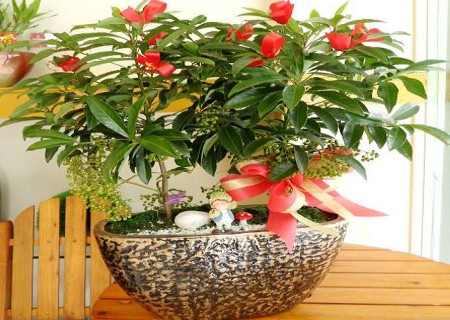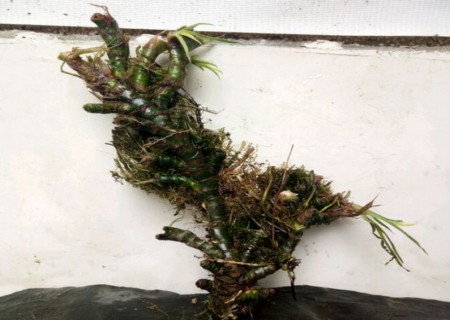How to raise cold orchid? Culture method of potted cold orchid
Cold orchid is an orchid plant, which is slender and graceful, with elegant and handsome leaves, colorful flowers and mellow fragrance for a long time. It is a good choice for making flower bonsai. A pot of cold orchid bonsai full of vitality and mystery will add a lot of color to the home. Cold orchid bonsai is very popular in the market. The flowers and colors of cold orchid bonsai in Yiyuan are symmetrical, gorgeous, delicious and flat, which can be described as a beauty in the flowers. At the same time, many people are still worrying about how to maintain the beauty "cold orchid bonsai" at home.
In order to raise Hanlan well, we must first understand the habits of Hanlan and study its characteristics. According to the author's observation and record of Cailan in recent years, wild Cymbidium generally grows in mountain forests with an altitude of 650MUR 1200 meters. The places where cold orchids grow are generally dense with trees and are often accompanied by capsule plants. Therefore, the degree of shading is relatively high. Hanlan is born in the mountain forest with relatively large slope, loose soil, rich corrosive content, good drainage, fresh air and high humidity to the southeast. The leaves of Hanlan are generally longer and thinner, and most of the pseudobulbs are smaller (but the pseudobulbs of the natural hybrids of Hanlan and Cymbidium or Sijilan are larger), with well-developed roots, easy flowering and many scape.
Among the above characteristics, the long and thin leaves indicate that they need to be wet (air humidity) and are afraid of the sun. The small pseudo-bulb and well-developed root system indicate that the stored nutrients are less and need to be absorbed and replenished by roots and leaves in time. More flowering indicates that it consumes a lot of nutrients, so it likes fertilizer. In view of the above situation, a variety of comparative experiments have been done, the author believes that the cultivation of cold orchid should pay attention to the following seven aspects.
1. Carefully select planting materials
At present, soilless cultivation is popular, and hard plants are used to plant all kinds of orchids. The author has done a comparative test of many kinds of plant materials, and found that no matter what kind of plant materials, cold orchids should be mixed with some mountain mud (corrosive soil) to grow best. It may be that man is still unable to supplement the nutrients needed to meet the growth of cold orchid. It is recommended that the plant formula which is more suitable for the cultivation of cold orchid is recommended: pond cornerstone or gold plant stone (can also be replaced by coarse river sand or other hard plant material) 40%, mountain mud 35%. 15% of mushroom bran or sawdust and 10% of snake wood.
2. Proper and reasonable shading
As mentioned earlier, the cold orchid leaves are a little thinner, so too strong sunlight is easy to make the leaves suffer. The upper surface of the cold orchid leaves raised by some Lanyou is yellowish brown or dark brown, and the lower surface is still green is mild sunburn disease. Excessive sunlight is easy to appear banana tail, leaf yellowing, early aging and so on. In addition to affecting the normal growth and life span of orchids, the ornamental value is also greatly reduced. According to the author's practice, it is most suitable to raise cold orchids with a shade net of 65% in winter and 75% in spring and 50% in sunny days in summer and autumn (not shaded in rainy days). In short, under the premise of not burning orchid leaves, appropriate more sunlight is beneficial to the growth and flowering of orchids, must not be afraid of sunburn and put indoors for a long time or excessive shade.
3. Strictly control watering
This is the key to raising cold orchids (other orchids are similar). It is also one of the reasons why many novice orchids fail. Too much water will rot the root. The cold orchid planted by the author, whether large or small, is usually watered every 15 days in spring, every 7 days in summer, and once every 10 days in autumn, and is often not watered for more than 20 days or even a month in winter. In order to facilitate the relatively unified management of large and small pots, I use reasonable pots according to the number of seedlings and the developed degree of root system, that is, more seedlings are planted in large pots and fewer seedlings are planted in small pots. Large pots are used for those with developed roots and small pots for those with poor roots. Can also use strong seedlings with weak seedlings, rare and famous products with general varieties to accompany planting and other ways. By doing so, the watering cycle of large and small pots is basically the same. Pot soil to see dry and wet, watering that is thoroughly, usually a little dry as the principle. In this way, the cold orchid root system is developed, the growth is robust, and there are few rotten roots or premature root senescence.
4. Maintain air humidity according to Han Lan's habit of high air humidity, it is suitable to artificially create a relative humidity of 40% in the daytime and no less than 80% at night. Measures such as humidifier, ground sprinkler, pool or basin humidification can be adopted. The air humidity is high, the cold orchid leaf surface is bright green, the growth is good, easy to raise the full sealing tip of the first-class seedlings, but should remember to maintain ventilation.
5. Apply fertilizer scientifically
Cold orchid because the false bulb is small, the storage of nutrients is limited, coupled with easy to civilize and scape high flowers. Consume a lot of nutrients, so the cultivation of cold orchid mature grass strong seedlings, it is best to add a small amount of base fertilizer when changing the basin. The author found that the plant material mixed with about 1% of pig manure sterilized by ripening fermentation is the most conducive to the growth of cold orchid. However, new grass that has just come down the mountain, newly purchased grass that has been trafficked or mailed over a long distance and weak seedlings with incomplete roots must not be in a hurry to fertilize, otherwise they will suffer fertilizer damage. In addition, potassium dihydrogen phosphate and blue fungus king can be used alternately for foliar fertilization, once every seven to ten days, adding appropriate amount of urea during the period of new bud formation, and spraying high potassium fertilizer two or three times during the mature period of new seedlings to make the pseudobulbs enlarge. In order to make all kinds of nutrients more balanced, thin organic fertilizer can be applied once a month from April to June and September to October, such as rotten dry cake water, fishy water and so on. Special attention must be paid to fertilization in strict proportion, rather light than thick, otherwise it will cause fertilizer damage and regret.
6. Strictly guard against harmful pollution
Like other plants of the same genus, Hanlan prefers fresh air and pollution-free growth environment. Jianlan Garden should avoid nearby workshops and factories that emit thick smoke and produce a lot of dust. Family cultivation should be as far away from smoke windows, range hood and air conditioner outside tuyere as far as possible. At the same time, clean water with no pollution and moderate pH should be selected. In other words, people who feel fresh air, no smoke, less dust, no smell, well-ventilated environment are suitable for orchid cultivation. All drinking water can be used to water orchids. In addition, try not to smoke in the orchid room.
7. Timely prevention of insects and diseases
To do a good job in the sanitation of Orchid Garden and thoroughly eliminate insects, pathogens and infectious pathogens is the key to pest prevention and disease prevention. Secondly, cold orchid should be potted on the shelf, so it is easier to manage than land planting, no pollution, fewer diseases and insect pests. The third is timely spraying, which is generally the key to pest prevention and disease prevention in March-April in spring and October-November in autumn. During this period, disease prevention and insecticide can be sprayed once a month to half a month, and once a month or twice a quarter at the rest of the time. Fungicides such as methyl thiophanate, carbendazim, carbendazim and daconine can be used for disease prevention, and omethoate, quick killing, dimethoate, enemy killing and other fungicides can be used for insect control. Many of these orchid books are introduced, so I won't repeat them.
Warm reminder:
Whether the cold orchid can blossom, blossom well, float faint fragrance, maintenance is very important. Such as dark flowers, the light should be a little stronger, vegetarian heart a little more shady. Flower arrows begin to grow to before flowering, if you do not pay attention to plant protection, the flower bracts are easy to rot. For this reason, the bud of cold orchid is easy to be stung by mites, and the color of the pest is similar to that of the bud. If the flower is not controlled in time, the flower will not bloom. Therefore, it can be effectively prevented by spraying drugs such as Huakang No.1 and killing permethrin. In order to make the cold orchid fragrance clearer, the flower exhibition period should bask in the sun more, so that even at night, the fragrance will be elegant.
Time: 2019-05-31 Click:
- Prev

Culture method of potted Golden Thousand Flowers
Jinwanliang, commonly known as mountain longan in southern Fujian, is a kind of newly developed flower with easy to live and edible fruit. Ten thousand taels of gold, also known as the rich son, after the beginning of autumn, the red fruit can hang on the branches for as long as 16 months, so many people like to buy pots in New Year's Day and spring and put them on the windowsill and the case table.
- Next

What is dragon root calamus? How to raise calamus in dragon root?
Acorus calamus is a traditional flower of our country, it is not only a literary play with grass, but also a cultural carrier. The literati often put the calamus bonsai on the desk, and the elegant grass is paired with strange stones, moss, wooden seats and so on, which not only forms a fresh and elegant artistic conception, but also has the effect of being fresh and pleasant, calming the mind and awakening the brain.
Related
- Fuxing push coffee new agricultural production and marketing class: lack of small-scale processing plants
- Jujube rice field leisure farm deep ploughing Yilan for five years to create a space for organic food and play
- Nongyu Farm-A trial of organic papaya for brave women with advanced technology
- Four points for attention in the prevention and control of diseases and insect pests of edible fungi
- How to add nutrient solution to Edible Fungi
- Is there any good way to control edible fungus mites?
- Open Inoculation Technology of Edible Fungi
- Is there any clever way to use fertilizer for edible fungus in winter?
- What agents are used to kill the pathogens of edible fungi in the mushroom shed?
- Rapid drying of Edible Fungi

